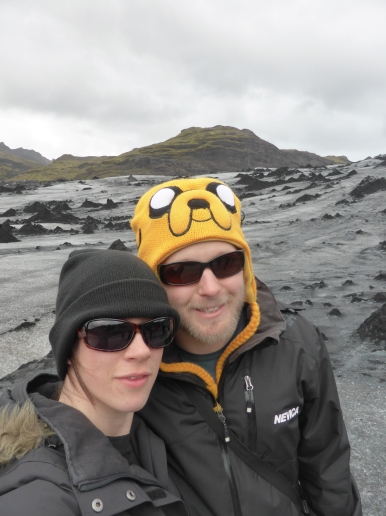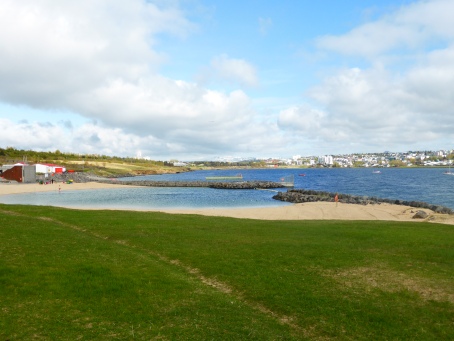It’s not like me to do a travel-based post, mainly because it’s not like me to travel, but that seems to be steadily changing. Tom and I had mapped out a hot beach getaway as an end-of-chemo (links here for backstory) treat and were just about to start booking when Tom was suddenly informed that some chemo drugs may significantly increase your risk of skin cancer for a long time after chemo if you try to tan. In the dozens of pages of gumpf we waded through from various charities and organisations, nowhere was this mentioned.
It was all pretty vague too but we hedged our bets and headed instead for the promisingly chilly sounding Iceland. It wasn’t actually that cold, but tanning opportunities were decidedly limited. Thankfully it was stunning and interesting enough to more than make up for that.
8 – The Icelandic Vikings held parliament on the Mid-Atlantic Ridge
Iceland is a geological baby at only 20 million years old. Its birth was the fiery product of intense volcanic activity as the Eurasian and North American tectonic plates migrated apart. Iceland still straddles the border between continents, and it’s got the scars to prove it.
The national park at Ϸingvellir (the Ϸ is pronounced “th”) lies directly above the Mid-Atlantic Ridge, and it’s a stunning visual guide to divergent tectonics. It actually looks like two giant hands have pressed down and tried to spread the land apart like dough. The wide, flat rift valley is bordered West and East by huge stepped fissures caused by the rock either side of the rift buckling and rupturing (rock isn’t quite as malleable as dough…). One of the biggest forms the background of the photo above.
The new Viking settlers of Iceland, oblivious to the geological significance of the place but attracted by the natural beauty and relatively convenient location, chose this place as the site of the first national parliament.
.
7 – Glacier selfie on Sólheimajökull!
Yes, Tom is wearing a Jake the Dog hat. The dark cones behind us originated when ash from an eruption of Mt Hekla in 1918 settled in natural crevices and depressions in the glacier surface. The ash insulated the ice underneath such that it melts much slower than the rest of the glacier. The valleys eventually became mini-mounds – ice cones with a thick ash frosting.
As we approached the glacier Sólheimajökull, we could see the wide gorge it had forged and then abandoned as it melts and retreats back up the mountain. It’s losing the distance of an Olympic swimming pool every year, not unusual for glaciers in this warming climate. With them go the main source of Iceland’s drinkable water, hydropower and the validity of Iceland’s name itself.
.
6 – The horsies are amazing and I want one
I think it would be pretty difficult to meet an Icelandic horse and not fall in love a little bit. The Icelanders love them too; they are friendly, easy to ride and hardy enough to manage perfectly well outside all year round without shelter or extra feeding. That said, they’re not above moseying up to passers-by in the hope of a bonus snack as this guy tried on with Tom.
They were introduced by the Vikings and since the year AD 930, no horse has been allowed to enter Iceland by law. This genetic and pathogenic isolation has kept the breed mostly unchanged and exposed to so few natural diseases that they do not need to be vaccinated.
I had the chance to ride an Icelandic horse called Vaka who showed me her tölt, an unusual gait which is pretty much unique to the Icelandic horse. The tölt is about the speed of a trot but so smooth the rider barely moves up-and-down at all. I suppose it’s rather like a horsey power-walk.
.
5 – Dem waterfalls…
Iceland has an almost obscene number of waterfalls; I felt decidedly spoilt by the time I left. It’s hard to say, but I think my favourite was Gullfoss, pictured above. It was only after I left that I realised how special it was to be able to be able to stare straight ahead at the top of a waterfall rather than having to squint up from the bottom or peer round a corner at it. The gulley that the water was covered by a rocky overhang and billowing with so much spray that it was impossible to see the bottom. It appeared to be tumbling voraciously into oblivion, which isn’t bad for something only 32 metres tall.
My opinion is not exactly an original one – Gullfoss has been named one of the top ten waterfalls in the world. Tom takes a slightly more hipster approach in preferring Seljalandsfoss. He’d never been behind a waterfall before (I only had once – a piddly little one in Wales) and this place provides a suitably epic place to start, so I can’t say I blame him!
.
4 – Basalt is a helluva rock
The sight of these imposing columns set on a black sand beach had me gawping in awe and wonder. Situated on the south coast of Iceland near the town of Vik, this is one of the most amazing geological structures I’ve ever seen with my own eyes. The columns, the black sand and the sea stack you see peeping out on the right hand side are all different forms of the same rock – basalt.
The photo above really doesn’t do justice to how huge the columns were (see a close-up). If it reminds you of the Giant’s Causeway in Ireland or the Devil’s Postpile in California, that’s because they are made of the same stuff and formed by the same process. The rock is lava flow which contracted as it cooled from the outside in. As the basalt shrunk in size, huge internal stresses built up until they were released by cracks which worked their way vertically down the rock all the way to the bottom.
.
3 – The Geysir all geysers are called geysers for isn’t much of a geyser any more
The area containing Geysir is one of the three main stops on the “Golden Circle” tour which is recommended to all incoming tourists. Geysir’s name comes from the Icelandic for “gush”. The intermittent but impressive spurts come about from a very specific feedback loop involving cool water and superheated steam.
Hundreds of years ago, Geysir’s gushes were so impressive that it’s ended up becoming a generic name, sort of like how Hoover became a generic term for vacuum cleaner. Yet the tight balance of forces that keep them going is easily disrupted. For the last hundred or so years Geysir had all but given up the ghost and is now a hot but inactive pool. It has delegated the job of tourist-wower to the smaller but more enthusiastic Strokkur next to it (seen above) which fires off every five minutes or so.
Old Geysir may be in remission but is occasionally revitalised by nearby earthquakes or, bizarrely, the addition of soap (which I like to think someone discovered after uttering the phrase “Dude, hold my beer”).
.
2 – “If you get lost in an Icelandic forest, just stand up”
Trees in Iceland are conspicuous by their absence. Where there are native trees, it is usually the downy birch Betula pubescens which rarely grows above two metres, hence the helpful phrase given above. Instead the landscape tends to be mossy plains, grassland or bare rocky terrain.
This wasn’t always the case. Birch scrub and woodland used to cover 25-40% of Iceland until about a thousand years ago. The problem, as is so often the case, was people. When the Vikings arrived they cut and burned most of the trees then put their livestock down for grazing which prevented regrowth.
For all its beauty, much of Iceland is now desert-like but there is a nationwide effort being made to restore some of the wooded majesty the early Viking sagas reference of their country.
.
1 – ICEland? Why not beach?!
After settling into our hotel room on our first day in Iceland, we took the typical exploratory walk around the hotel area. Whatever we expected to find, it certainly wasn’t an imported white sand beach with dazzling blue water and a huge free-to-use hot tub, brimming with semi-naked people clearly enjoying the contrast of the hot water and the slightly biting cold air. One of the perks of being an Icelander is very cheap hot water thanks to an abundance of geothermal energy and very efficient water transport systems meaning the water never cools down from its volcanic source and so never has to be heated up again. Still, in a beach context it was gloriously incongruent.
It seems we were pretty much alone in not knowing about this little gem, because it apparently attracts over 500,000 visitors a year – more than the entire population of Iceland!
Iceland was an amazing place and while the capital Reykjavik can be explored in a day or two, the country overall merited a lot longer than the week we allowed ourselves. More photos can be found in this imgur album and if you have any questions or comments, do get in touch! The header image is a collapsed crater cone, called Kerith.
.








